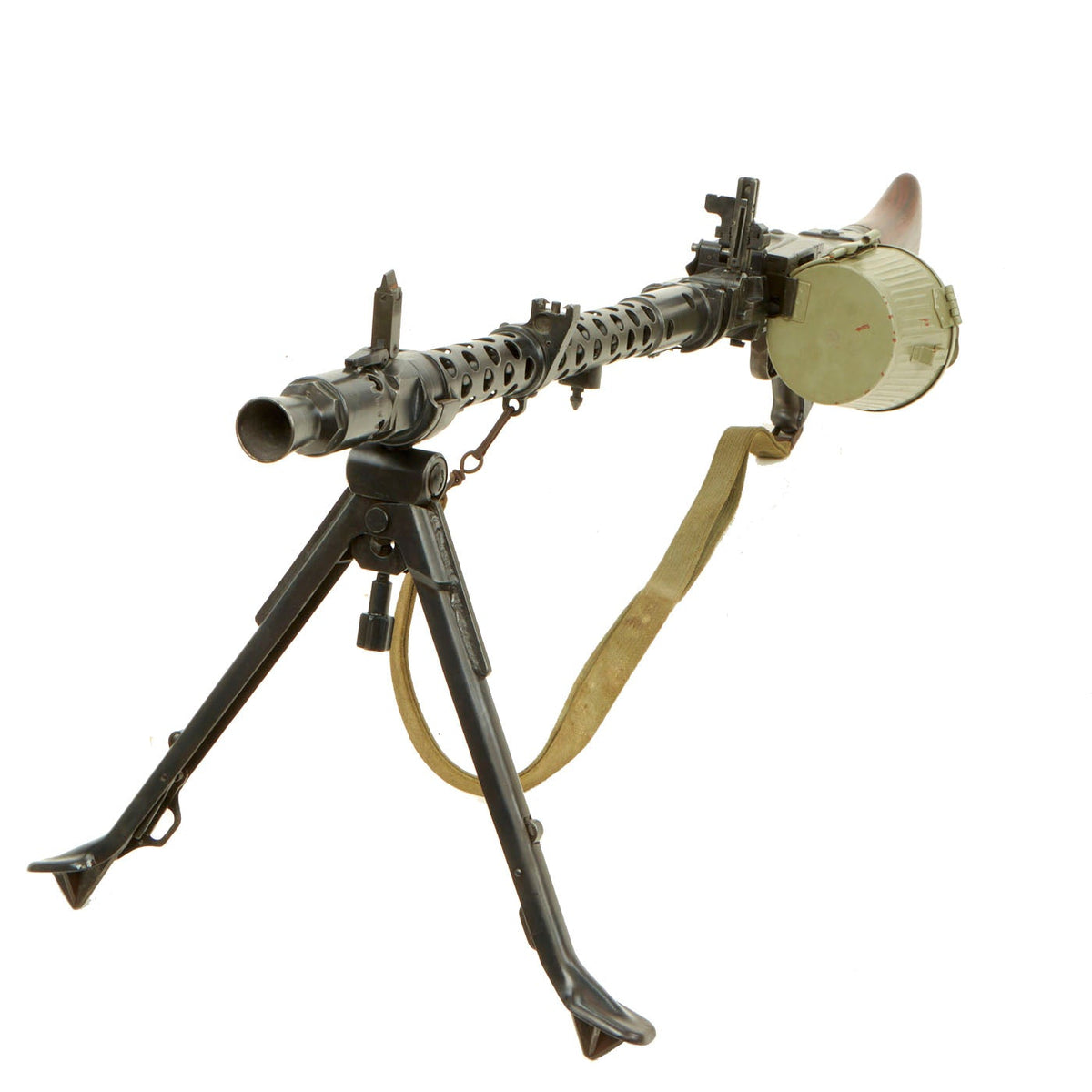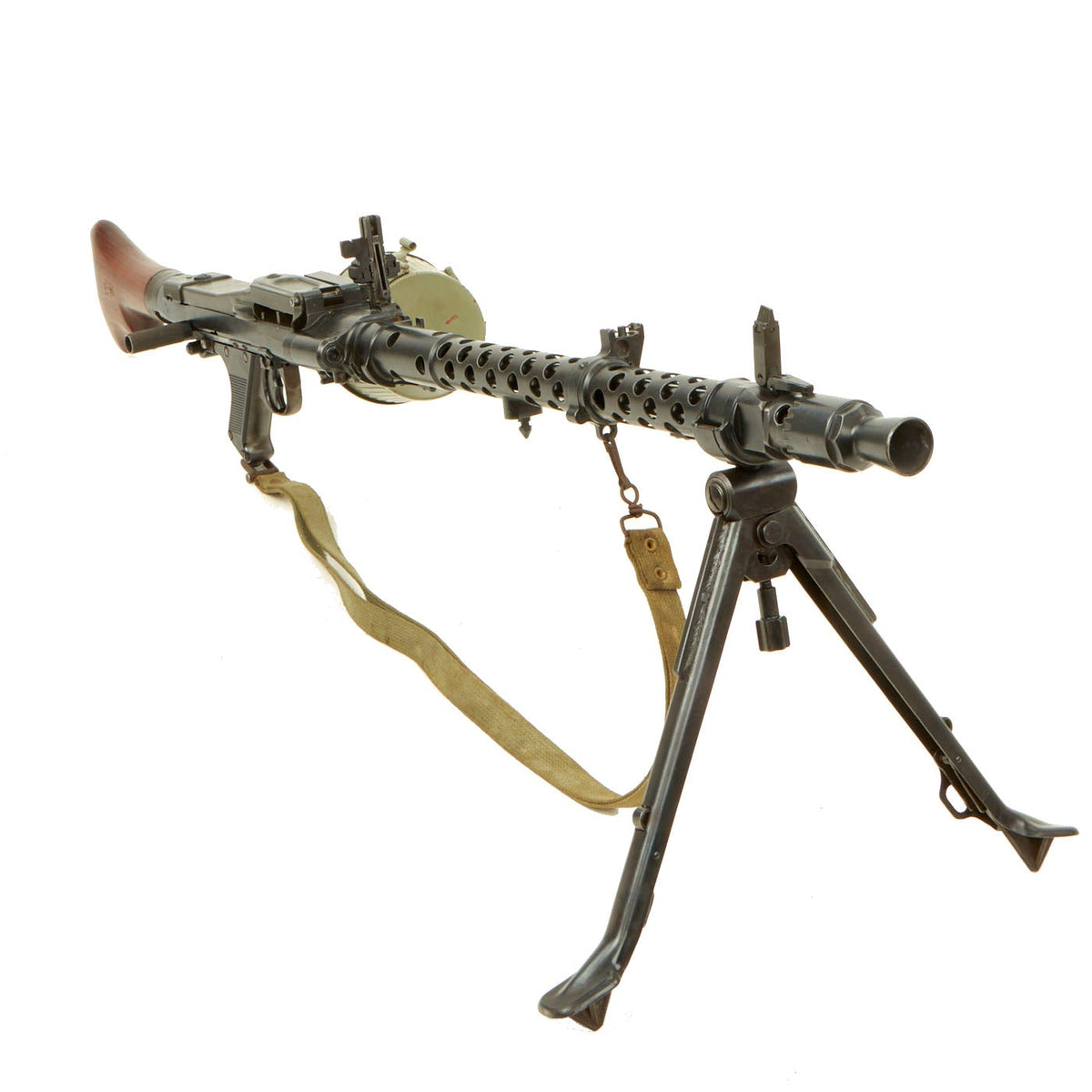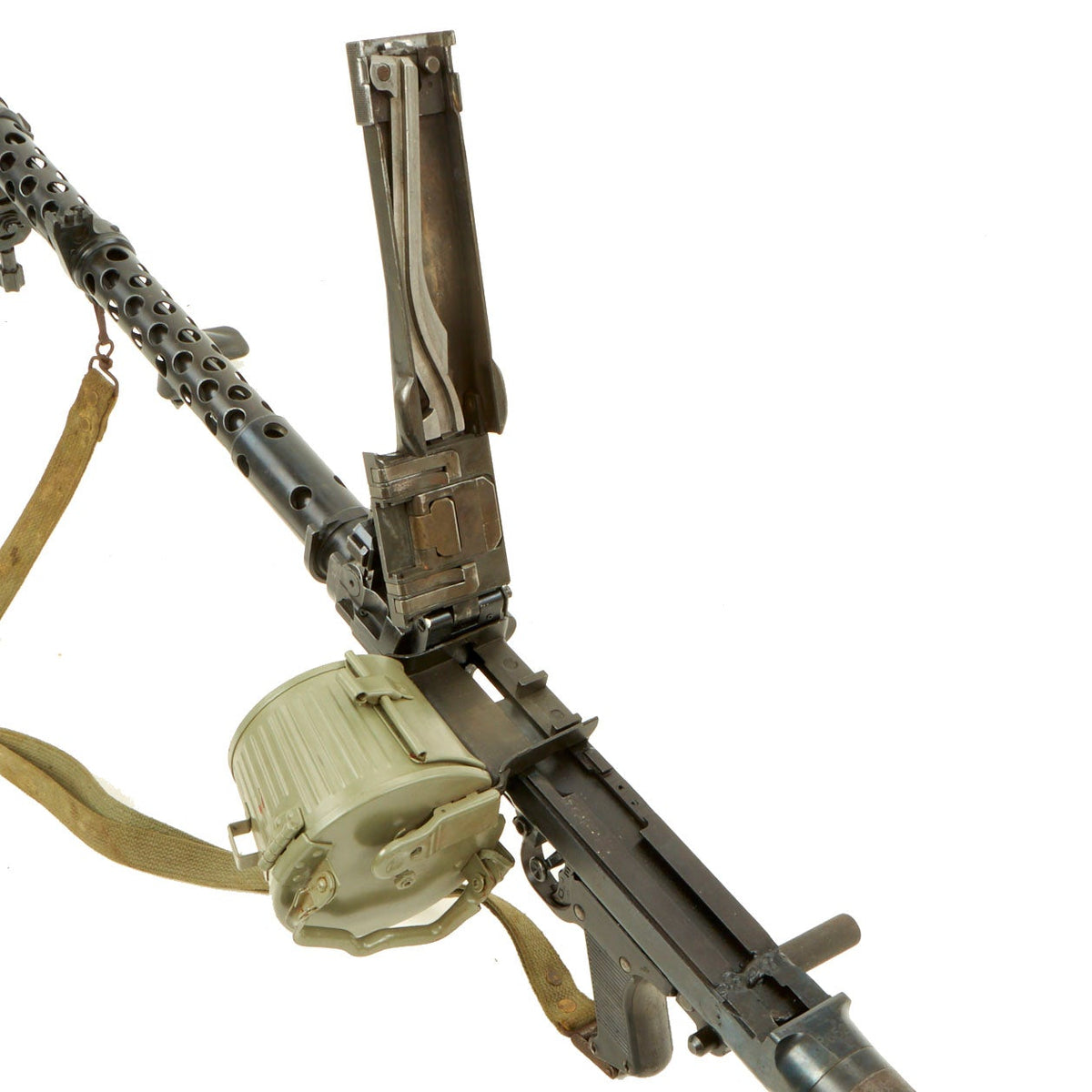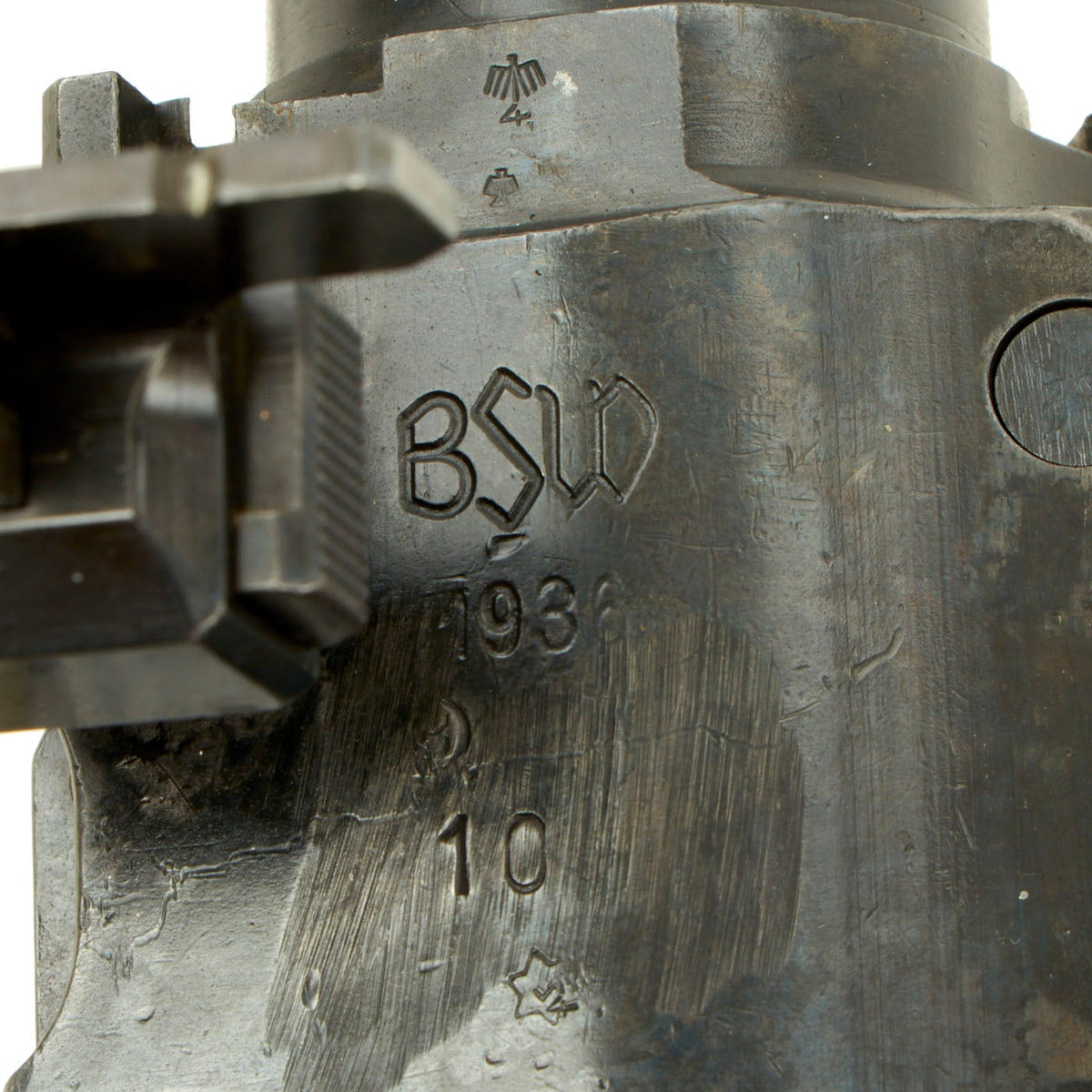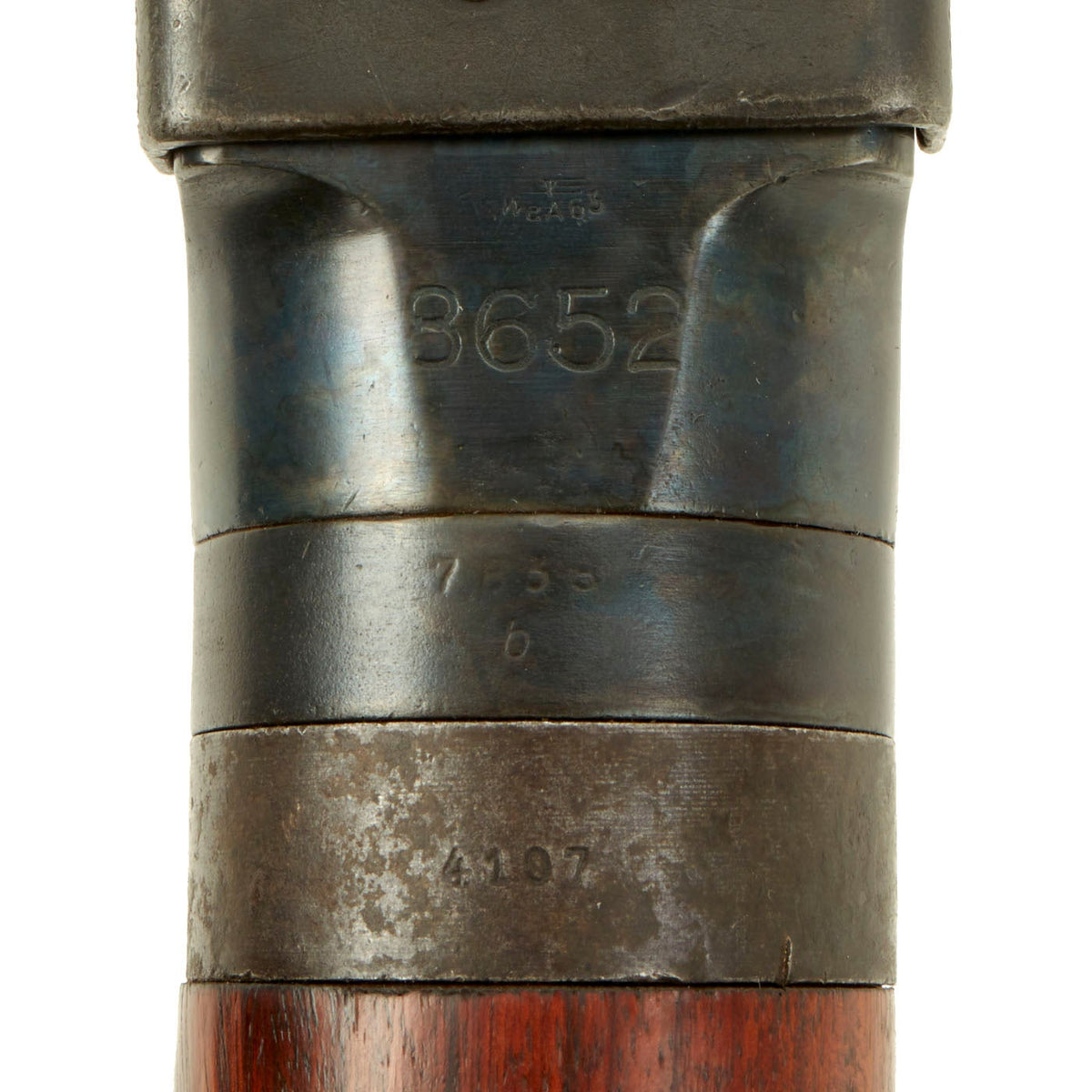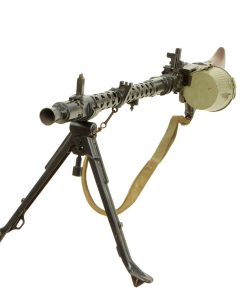Original German Pre-WWII Early MG 34 Display Machine Gun by BSW with Belt Carrier – dated 1936 Original Items
$ 4.195,00 $ 1.048,75
Original Item: Only One available! This is an excellent original Pre-WWII issue German MG34 display machine gun, dated 1936, and is the earliest that we have ever had! 1936 was the first year of official issue to the German Wehrmacht, so it is unlikely we will ever seen another! It is coded along with multiple German wartime markings and has multiple Waffenamt markings. Due to how early it is, many of these are Weimar “Stick Eagle” inspection markings. We have also included a post war repainted belt drum and sling to complete the look.
The barrel jacket is has had the serial number ground off and replaced by 10, but the maker marking and date are still clear:
BSW
1936
This is the abbreviation for Berlin Suhler Waffen- und Fahrzeugwerke (Berlin Suhl Weapons and Vehicle works), a factory with a long but controversial history. It was originally known as Gebrüder Simson (Simson Brothers) and later Simson & Co., based in Suhl, Thuringia and founded in the mid 19th century. Originally a maker of bayonets and other edged weapons, later moving into making bicycles and small motor vehicles in the late 19th century. The company continued trading after WWI and was again successful, however since the Simson family were Jewish, they found the company headquarters occupied by the SA in 1933. With the family now exiled from their own factory, the company was then forcibly renamed BSW and pressed into service making small arms, beginning with the MG 13 machine gun. Thankfully, the Simson family was able to emigrate to the U.S.A. in 1936.
In 1939, the factory was renamed to Gustloff-Werke – Waffenwerk Suhl, named after assassinated Swiss NSDAP member Wilhelm Gustloff. This company would continue manufacturing MG 34 and MG 42 machine guns under German three letter code “dfb”.
The top cover has had the maker marking removed, however the feed tray is still marked with cof for Carl Eickhorn, a legendary manufacturer of edged weapons, and a known maker from Solingen, the legendary “City of Blades”. They also manufactured other top cover components for the MG 34 and 42. There are some great markings on this very fine example of the most prolific German issued Light Machine gun of WWII.
Comprised of nearly entirely original WWII parts, this display gun was reconstructed using a BATF approved receiver with 2 inches totally replaced with solid bar stock, making this an inert non-firing display gun. We have not had these available for years!
The bipod included is of the early/pre war design, with a central height adjustment knob. It is marked dqc on the central portion, for maker Eugen Ising, a metalworking business in Bergneustadt / Rheinland. There are also more “Stick Eagle” Waffenamt proofs on the legs.
Front and rear sight still flip up and function correctly, and the bipod folds away and locks in correctly. The wooden butt stock is in very good condition, most likely an arsenal replacement from late in the war. It is maker coded and dated 1944.
An excellent example of a very early issue German MG34 Display gun, the earliest we have ever had! Ready to add to your collection and display!
Please note that there may be various post-war markings on this display gun, in addition to the German WW2 markings.
The Maschinengewehr 34, or MG 34, is a German recoil-operated air-cooled machine gun, first tested in 1929, introduced in 1934, and issued to units in 1936. It accepts the 7.92×57mm Mauser cartridge, and is generally considered the world’s first general-purpose machine gun.
The versatile MG 34 was arguably the most advanced machine gun in the world at the time of its deployment. Its combination of exceptional mobility – being light enough to be carried by one man – and high rate of fire (of up to 900 rounds per minute) was unmatched. It entered service in great numbers following AH’s repudiation of the Versailles Treaty in 1936, and was first combat tested by German troops aiding Franco’s Nationalists in the Spanish Civil War. Nonetheless, the design proved too complex for mass production, and was supplemented by the cheaper and simpler MG 42, though both remained in service and production until the end of the war.
History
The MG 34 was based on a 1930 Rheinmetall design, the MG 30. The Swiss and Austrian militaries had both licensed and produced the MG 30 from Rheinmetall shortly after patent. The MG 30 design was adapted and modified by Heinrich Vollmer of Mauser Industries. Vollmer modified the feed mechanism to accept either drum magazines or belt ammunition. He also increased the rate of fire. The MG 34’s double crescent trigger dictated either semiautomatic or fully automatic firing modes.
In the field, the weapon could operate in offensive or defensive applications. The offensive model, with a mobile soldier, used a drum magazine that could hold either 50 or 75 rounds of ammunition. In a stationary defensive role, the gun was mounted on a bipod or tripod and fed by an ammunition belt. Belts were carried in boxes of five. Each belt contained 50 rounds. Belt lengths could be linked for sustained fire. During sustained fire, barrels would have to be changed at intervals due to the heat generated by the rapid rate of fire. If the barrels were not changed properly, the weapon would misfire. Changing barrels was a rapid process for the trained operator and involved disengaging a latch and swinging the receiver to the right for the insertion of a new barrel. Accordingly, stationary defensive positions required more than one operator.
The MG 34 was the mainstay of German Army support weapons from the time of its first issue in 1935 until 1942, when it was supplanted by the next generation Maschinengewehr 42 or MG 42. Although the 34 was very reliable and dominant on the battlefield, its dissemination throughout the German forces was hampered due to its precision engineering, which resulted in high production costs and a relatively slower rate of production. For its successor, the MG 42, the Germans instead used mass production techniques similar to those that created the MP 40 submachine gun. However, the Germans nevertheless continued widespread production of MG 34s until the end of the war.
The MG 34 was used as the primary infantry machine gun during the 1930s, and remained as the primary armored vehicle defensive weapon. It was to be replaced in infantry service by the related MG 42, but there were never enough quantities of the new design to go around, and MG 34s soldiered on in all roles until the end of World War II. The MG 34 was intended to replace the MG 13 and other older machine guns, but these were still being used in World War II as demand was never met.
It was designed primarily by Heinrich Vollmer from the Mauser Werke, based on the recently introduced Rheinmetall-designed Solothurn 1930 (MG 30) that was starting to enter service in Switzerland. Changes to the operating mechanism improved the rate of fire to between 800 and 900 rpm.
The new gun was accepted for service almost immediately and was generally liked by the troops, and it was used to great effect by German soldiers assisting Nationalist Spain in the Spanish Civil War. At the time it was introduced, it had a number of advanced features and the general-purpose machine gun concept that it aspired to was an influential one. However, the MG 34 was also expensive, both in terms of construction and the raw materials needed (49 kg (108.0 lb) of steel),[citation needed] and its manufacture was too time-consuming to be built in the numbers required for the ever-expanding German armed forces. It was the standard machine gun of the Kriegsmarine (German navy).
Fast Shipping with Professional Packaging
Thanks to our longstanding association with UPS FedEx DHL, and other major international carriers, we are able to provide a range of shipping options. Our warehouse staff is expertly trained and will wrap your products according to our exact and precise specifications. Prior to shipping, your goods will be thoroughly examined and securely secured. We ship to thousands clients each day across multiple countries. This shows how we're dedicated to be the largest retailer on the internet. Warehouses and distribution centres can be located throughout Europe as well as the USA.
Note: Orders with more than one item will be assigned a processing date depending on the item.
Before shipping before shipping, we'll conduct a thorough inspection of the items you have ordered. Today, the majority of orders will be delivered within 48 hours. The delivery time will be between 3-7 days.
Returns
The stock is dynamic and we cannot completely manage it because multiple stakeholders are involved, including our factory and warehouse. So the actual stock may alter at any time. It's possible that you may not receive your order once the order has been made.
Our policy is valid for a period of 30 days. If you don't receive the product within 30 days, we are not able to issue a refund or an exchange.
You can only return an item if it is unused and in the same state as the day you received it. You must have the item in its original packaging.
Related products
Uncategorized
Uncategorized
Uncategorized
Uncategorized
Uncategorized
Uncategorized
Armoured Fighting Vehicles of the World: AFVs of World War One (Hardcover Book) New Made Items
Uncategorized
Uncategorized
Uncategorized
Uncategorized
Uncategorized
Uncategorized
Uncategorized
Uncategorized
Uncategorized
Band of Brothers ORIGINAL GERMAN WWII Le. F.H. 18 10.5cm ARTILLERY PIECE Original Items
Uncategorized
Uncategorized
Uncategorized
Uncategorized
Angolan Rebel 1970s era 60mm Inert Display Mortar from Angolan Civil War Original Items
Uncategorized
